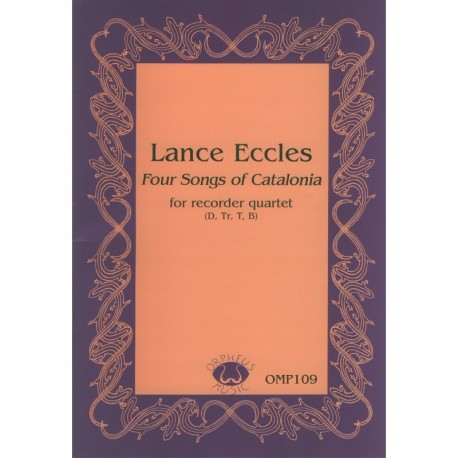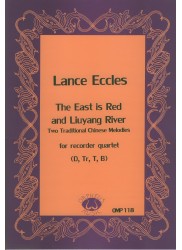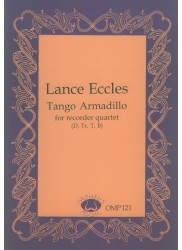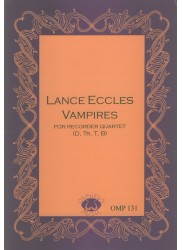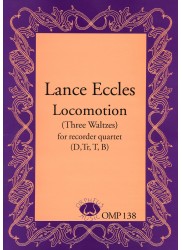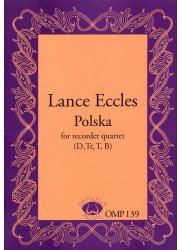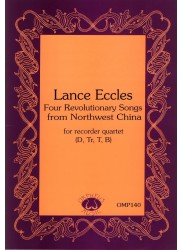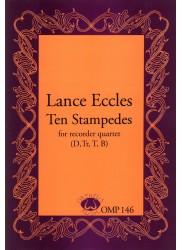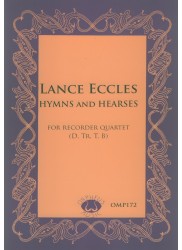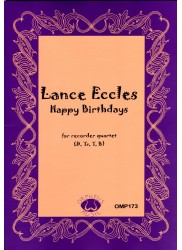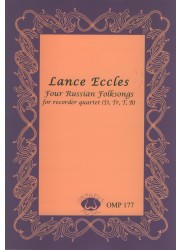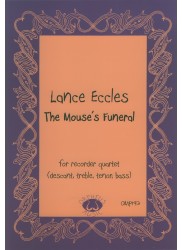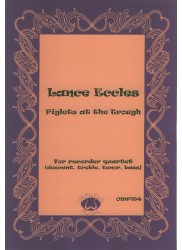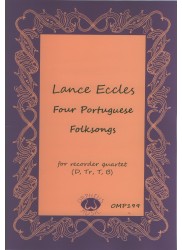No products
Prices are tax included
Four Songs of Catalonia
Composer: Eccles - Lance
Instrumentation: Descant - Treble - Tenor - Bass
Period/genre: Mixed
Grade: Moderate
More info
*Contemporary Pieces.* An attractive set of pieces with lots of interest in all parts.
_Score 12 pp. Parts 4 pp._
OMP109 Lance Eccles Four Songs of Catalonia
Lance Eccles has an enviable talent for spotting unusual yet attractive folk songs and then turning them into simple yet attractive arrangements. His movements are deceptively straightforward - generally just a series of iterations of the tune, often with a slowly developing accompanying texture - but each is finely judged and very playable.
The Catalonian songs comprise a spinning girl (who doesn't seem to have her mind on the job, as she spins a very fragmentary thread), some reapers (who appear a little drunk as they keep missing a beat), a thief (whose rather operatic tune seems a little inappropriate for one who follows such a stealthy profession) and a very fast Lady of Aragon (who manages to keep going for a cool 120 bars in spite of suffering the same incapacity as the reapers).
The music is not technically difficult; there are some rhythmical complexities, but as these tend to occur simultaneously in all parts they do not present a serious problem.
Greg Lewin, The Recorder Magazine, Autumn 2001
OMP109 Lance Eccles Four Songs of Catalonia
These are agreeable arrangements-cum-compositions, and the four Catalonian song melodies chosen have been treated simply and resourcefully in the course of these pieces.
In No. 3, a lovely Andante movement, the time-signature should be 4/4 rather than 2/2, and the groups of semi-quavers should be slurred together under one tongue. Oddly enough, there are no slurs anywhere in this score, and some may need adding here and there according to taste and players' comfort.
In No. 4 the movement should end with a da capo of bars 1-13 so as to finish with a tonic chord, rather than finishing with the dominant chord that comes at the end of the piece here.
The parts lie easily on the instruments, although the treble part is at times pitched rather high for some relatively long passages.
Gwilym Beechey, The Recorder Magazine, Summer 2004
30 other products in the same category:
Reference: OMP109.pdf
Brand: Orpheus Music
Four Songs of Catalonia
PLEASE NOTE - DOWNLOADABLE PDF VERSION Composer: Eccles - Lance...
$22.00 -20%In StockReference: OMP118
Brand: Orpheus Music
The East is Red and Liuyang River
Composer: Eccles - LanceInstrumentation: Descant - Treble - Tenor -...
In StockReference: OMP118.pdf
Brand: Orpheus Music
The East is Red and Liuyang River
PLEASE NOTE - DOWNLOADABLE PDF VERSION Composer: Eccles -...
$17.50 -20%In StockReference: OMP121
Brand: Orpheus Music
Tango Armadillo
Composer: Eccles - LanceInstrumentation: Descant - Treble - Tenor -...
In StockReference: OMP121.pdf
Brand: Orpheus Music
Tango Armadillo
PLEASE NOTE - DOWNLOADABLE PDF VERSION Composer: Eccles -...
$16.00 -20%In StockReference: OMP129
Brand: Orpheus Music
Ruins
Composer: Eccles - LanceInstrumentation: Descant - Treble - Tenor -...
In StockReference: OMP129.pdf
Brand: Orpheus Music
Ruins
PLEASE NOTE - DOWNLOADABLE PDF VERSION Composer: Eccles -...
$22.00 -20%In StockReference: OMP130
Brand: Orpheus Music
Avarice
Composer: Eccles - LanceInstrumentation: Descant - Treble - Tenor -...
In StockReference: OMP130.pdf
Brand: Orpheus Music
Avarice
PLEASE NOTE - DOWNLOADABLE PDF VERSION Composer: Eccles -...
$20.50 -20%In StockReference: OMP131
Brand: Orpheus Music
Vampires
Composer: Eccles - LanceInstrumentation: Descant - Treble - Tenor -...
In StockReference: OMP131.pdf
Brand: Orpheus Music
Vampires
PLEASE NOTE - DOWNLOADABLE PDF VERSION Composer: Eccles -...
$20.50 -20%In StockReference: OMP138
Brand: Orpheus Music
Locomotion
Composer: Eccles - LanceInstrumentation: Descant - Treble - Tenor -...
In StockReference: OMP138.pdf
Brand: Orpheus Music
Locomotion
PLEASE NOTE - DOWNLOADABLE PDF VERSION Composer: Eccles -...
$20.50 -20%In StockReference: OMP139
Brand: Orpheus Music
Polska
Composer: Eccles - LanceInstrumentation: Descant - Treble - Tenor -...
In StockReference: OMP139.pdf
Brand: Orpheus Music
Polska
PLEASE NOTE - DOWNLOADABLE PDF VERSION Composer: Eccles -...
$20.50 -20%In StockReference: OMP140#
Brand: Orpheus Music
Four Revolutionary Songs from North West China
Composer: Eccles - Lance Instrumentation: Descant - Treble - Tenor - Bass...
In StockReference: OMP146
Brand: Orpheus Music
Ten Stampedes
Composer: Eccles - LanceInstrumentation: Descant - Treble - Tenor -...
In StockReference: OMP146.pdf
Brand: Orpheus Music
Ten Stampedes
PLEASE NOTE - DOWNLOADABLE PDF VERSION Composer: Eccles -...
$36.00 -20%In StockReference: OMP172
Brand: Orpheus Music
Hymns and Hearses
Composer: Eccles - LanceInstrumentation: Descant - Treble - Tenor -...
In StockReference: OMP172.pdf
Brand: Orpheus Music
Hymns and Hearses
PLEASE NOTE - DOWNLOADABLE PDF VERSION Composer: Eccles -...
$28.00 -20%In StockReference: OMP173
Brand: Orpheus Music
Happy Birthdays
Composer: Eccles - LanceInstrumentation: Descant - Treble - Tenor -...
In StockReference: OMP173.pdf
Brand: Orpheus Music
Happy Birthdays
PLEASE NOTE - DOWNLOADABLE PDF VERSION Composer: Eccles -...
$20.50 -20%In StockReference: OMP177
Brand: Orpheus Music
Four Russian Folksongs
Composer: Eccles - LanceInstrumentation: Descant - Treble - Tenor -...
In StockReference: OMP177.pdf
Brand: Orpheus Music
Four Russian Folksongs
PLEASE NOTE - DOWNLOADABLE PDF VERSION Composer: Eccles - Lance...
$20.50 -20%In StockReference: OMP193
Brand: Orpheus Music
The Mouse's Funeral
Composer: Eccles - LanceInstrumentation: Descant - Treble - Tenor -...
In StockReference: OMP193.pdf
Brand: Orpheus Music
The Mouse's Funeral
PLEASE NOTE - DOWNLOADABLE PDF VERSION Composer: Eccles -...
$20.50 -20%In StockReference: OMP194
Brand: Orpheus Music
Piglets at the Trough
Composer: Eccles - LanceInstrumentation: Descant - Treble - Tenor -...
In StockReference: OMP194.pdf
Brand: Orpheus Music
Piglets at the Trough
PLEASE NOTE - DOWNLOADABLE PDF VERSION Composer: Eccles -...
$20.50 -20%In StockReference: OMP199
Brand: Orpheus Music
Four Portuguese Folksongs
Composer: Eccles - LanceArranger: Lance EcclesInstrumentation: Descant -...
In StockReference: OMP199.pdf
Brand: Orpheus Music
Four Portuguese Folksongs
PLEASE NOTE - DOWNLOADABLE PDF VERSION Composer: Eccles - LanceArranger:...
$22.00 -20%In Stock

